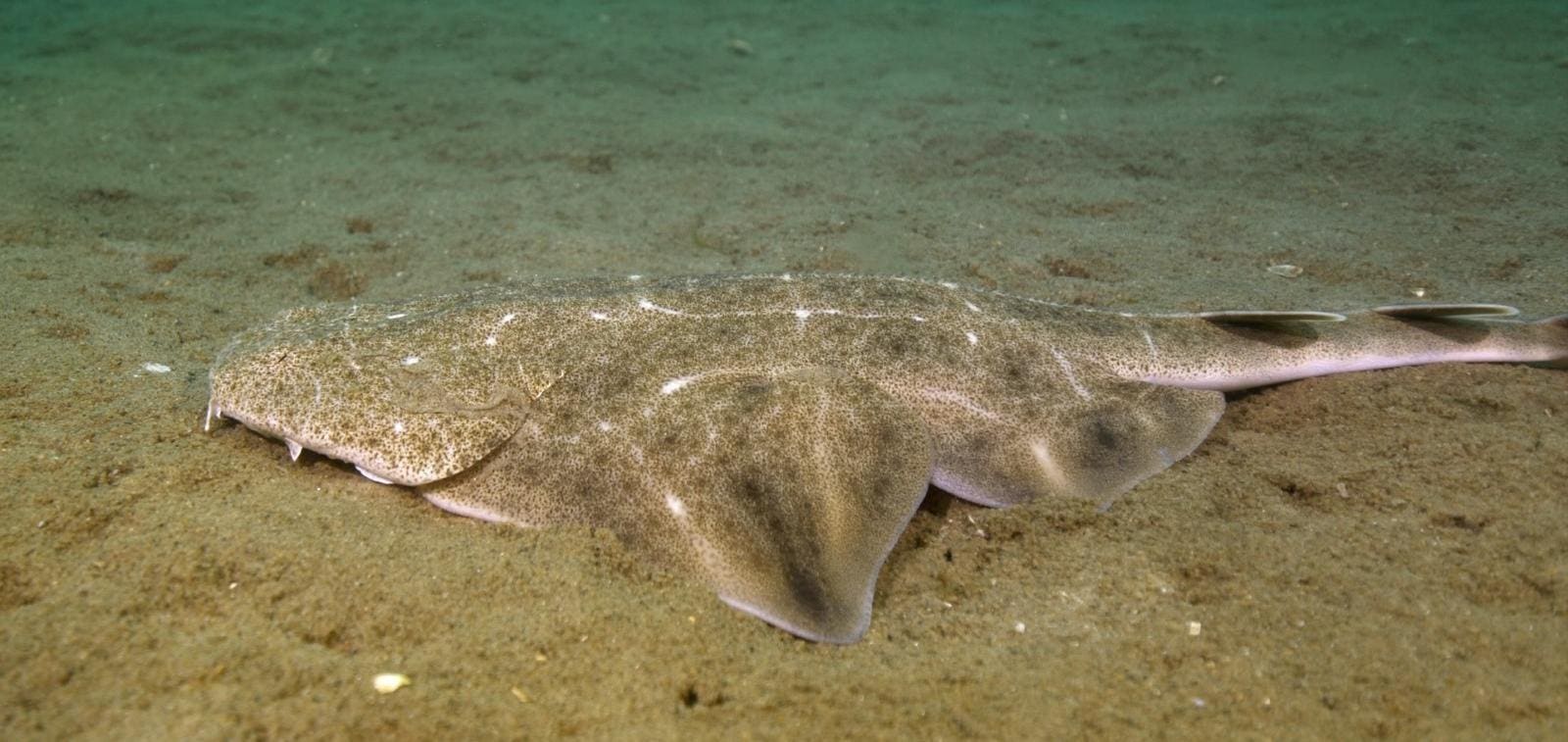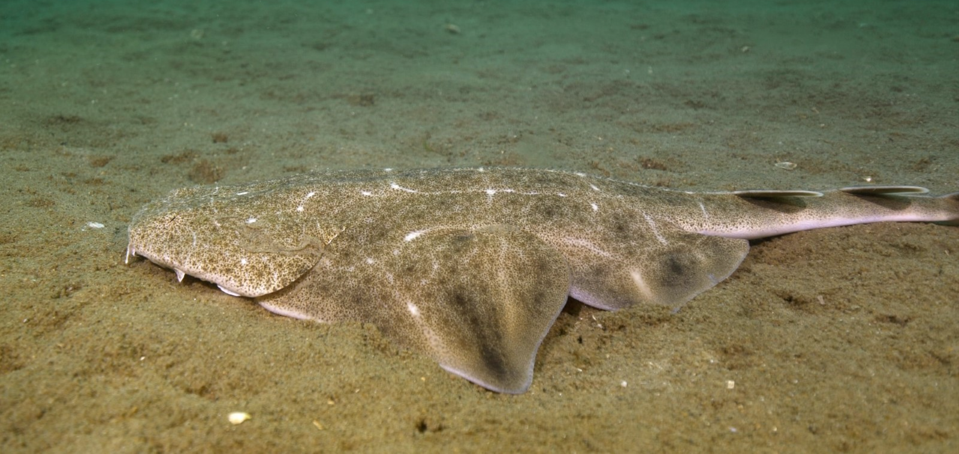Angelshark in Cardigan Bay.
For years, the future for Wales’ angelshark population has looked… well, pretty bleak, to be honest. Once common in the coastal waters of the British Isles, the angelshark has become a rare and mysterious figure. Official assessments suggest their numbers have plummeted by as much as 70% since 1970, and they’ve been listed as Critically Endangered by the International Union for Conservation of Nature since 2006. But a new study led by the Zoological Society of London offers a surprising twist to this animal’s tale: that dramatic decline may not be as steep as we thought.
Angelsharks are hard to spot even under the best conditions. Their flat, ray-like bodies and sandy, speckled coloration make them almost invisible when they’re lying motionless on the seafloor. They often bury themselves just beneath the sand, with only their eyes and a portion of their head exposed; from here, they ambush unsuspecting prey (typically smaller fish or crustaceans) with a lightning-fast upward strike. Angelsharks can grow up to 8 feet long (about 2.4 meters) and are the only angelshark species found in Atlantic waters of northeast Europe. Historically, they were widespread across the continental shelf around the British Isles, but today their range has shrunk considerably, with Wales now considered one of their last strongholds in this region. Their preference for shallow, sandy coastal areas puts them in direct conflict with human activities, like bottom-trawling, dredging, and other destructive fishing methods that disturb the seabed where angelsharks rest and hunt. These methods not only destroy this predator’s habitat, but can also unintentionally catch, injure, or kill them. Coastal development, pollution and increasing human pressure on inshore ecosystems only add to the threats these sharks face.”
But the study suggests that fewer sightings of angelsharks might be a result of changes in fishing practices over the last 50 years. To better understand how changes in fishing have affected angelshark encounters, researchers from ZSL and Natural Resources Wales partnered with the Welsh Fishermen’s Association and Angling Cymru. They interviewed 27 fishers who have operated in Welsh waters between 1968 and 2019, asking about the ecological, economic and regulatory changes they’ve witnessed. What they found was a landscape transformed. There’s now new fishing regulations, shifts in target species, the rise of more species-specific gear and even changing social attitudes which have all contributed to fishers spending less time in angelshark habitats. The result? Far fewer accidental catches or sightings, and not necessarily because the sharks are gone, but because people just aren’t fishing where the sharks are.
Francesca Mason, lead author of the study and a researcher at ZSL’s Ocean Predator Lab, says studying this shift is critical to understanding the species’ true status. “Identifying how changes to fishing practices over the last 51 years have impacted our ability to monitor them indicates that there may be more angelsharks swimming off the Welsh coast than we previously thought – we’re just having a harder time spotting them,” she explained. “While this is a good sign if less angelsharks are being caught accidentally, it also means we now need new ways to monitor them to build a more accurate picture of how these sharks are doing.
Fisher with angelshark caught near Aberdyfi in the 1980s.
That’s why the team has pointed to a powerful new tool available in their arsenal: environmental DNA, or eDNA. Instead of relying on catching or spotting angelsharks (which is getting increasingly difficult) they can now look for traces of their genetic material in the water. As sharks shed skin cells or bleed from minor wounds, that DNA essentially “floats” into the environment, where researchers can collect and analyze it. This technique has already confirmed the presence of angelsharks in areas like Cardigan and Carmarthen Bays, two places where traditional monitoring methods are no good due to low visibility and rough conditions. “With their excellent camouflage, one of the hardest challenges we face studying angelsharks is simply finding them,” Jake Davies, Technical Specialist for Project SIARC at ZSL and NRW, said in a press release. “eDNA allows us to study species without having to spot them.”
“[This] work highlights why conservation works best when we bring people together and combine the knowledge of those living alongside these creatures with cutting-edge research and science,” Mason continued. Charlie Bartlett, a co-author of the study and a charter fisher from Gwynedd, has seen the benefits of this collaboration firsthand. Having worked along the Welsh coast for more than 50 years, he’s encountered angelsharks in the past and contributed his knowledge, photos and logbooks to the research. For him, the project isn’t just about sharks — it’s also about preserving the marine heritage of Wales. “It’s been great to share personal experiences that help better understand angelsharks,” he says. “That information is not just important for the species but also for inspiring future generations.”
Angelsharks remain one of the world’s most threatened sharks, ranked as the fifth most Evolutionarily Distinct and Globally Endangered (EDGE) species. Their loss would represent not just a local extinction, but the disappearance of a unique lineage of life. Projects like “Angel Shark Project: Wales” and the wider Project SIARC are thankfully creating a more accurate picture of what’s happening beneath the waves — and what needs to happen next to keep this species from disappearing for good. While the new study doesn’t mean angelsharks are thriving, it does offer a glimmer of hope for their future. It also, the team argues, should make scientists and conservationists rethink how we assess their populations.









